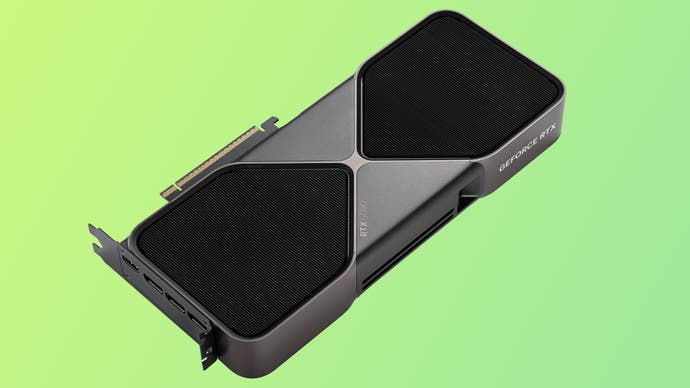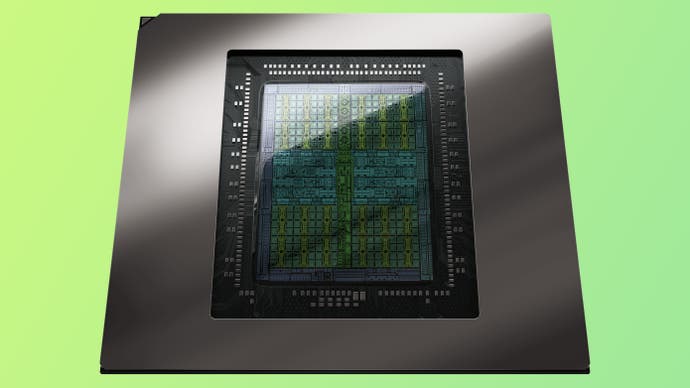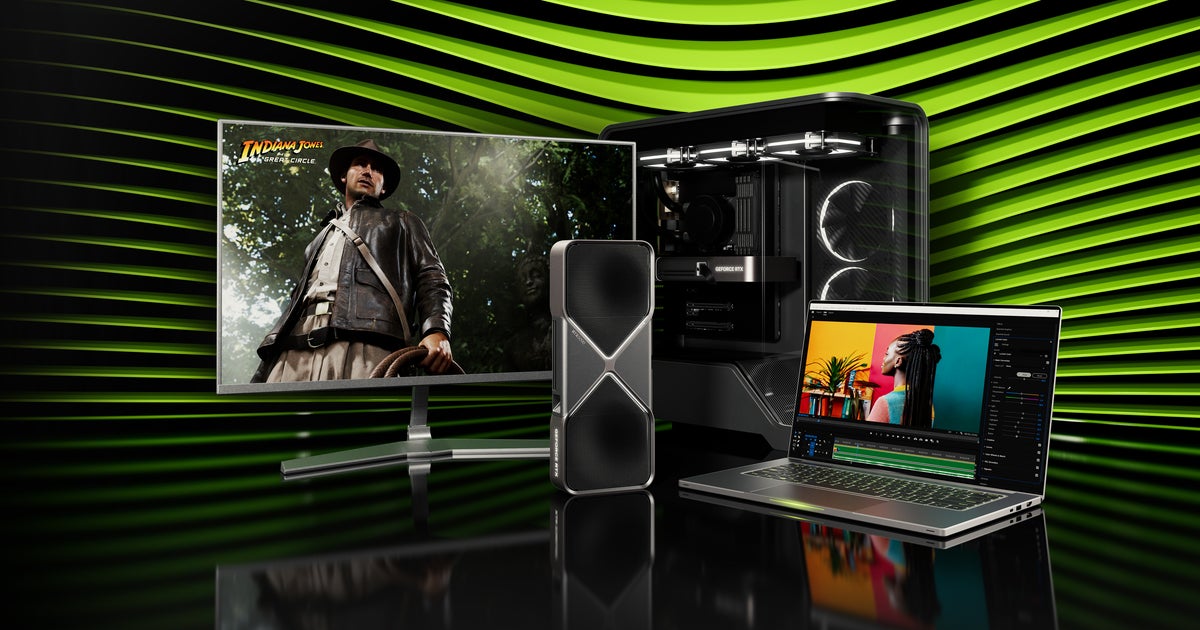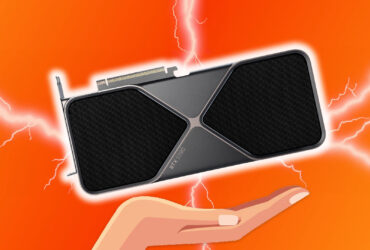As was foretold, Nvidia has revealed its new RTX 50-series desktop graphics cards at its CES 2025 keynote, which took place in the early hours UK time. The current lineup includes four cards: a $1999/£1939 RTX 5090, a $999/£979 RTX 5080, a $749/£729 RTX 5070 Ti and a $549/£539 RTX 5070. Each “Blackwell” graphics card comes equipped with GDDR7 memory, some impressive frame-rate claims and DLSS 4 multi frame generation. The two top-end cards are arriving on 30th January, while the upper-mid-range offerings are scheduled for February.
The “relative performance” claims for some of these graphics cards are wild, so let’s start with an idea of expected frame-rates for each card and a quick explainer of DLSS 4 multi frame generation before we cover off the architectural improvements.
The $1999 RTX 5090 is unsurprisingly positioned as the ultimate graphics card, a prosumer model with 32GB of GDDR7. It’s based around the GB202 GPU with 92 billion transistors, versus 76 billion on the 4090, and includes 21760 CUDA cores. Nvidia’s slides promise double the frame-rates of the RTX 4090, or a comfortable 4K 240Hz with full RT and maxed settings in games that support the multi frame generation (MFG) feature.


To explain before we go further, MFG adds in up to three generated frames for each traditionally rendered frame. This results in higher frame-rates and therefore visual fluidity, but not necessarily higher performance as we’d typically label it, as latency is reliant on the “base” frame-rate rather than the final “output” frame-rate. The concept is similar to the original frame generation (FG) feature on RTX 40-series cards, and as such relies on developer integration and Nvidia’s Reflex 2 latency mitigation tech to work well.
Surprisingly, while the RTX 5090 has a rated total graphics power of 575W – right up against the PCIe 5.0 600W limit and 125W higher than the RTX 4090 – the Founders Edition design is actually slimmer than the RTX 4090 FE. It’s a two-slot card that may actually fit in small form factor PC cases (with requisite 1000W PSUs), with two flow-through fans and the PCB located in the centre. It’ll be fascinating to see how the new design performs, given that early 5090 prototype coolers were reportedly quad-slot behemoths!
The $999 RTX 5080 is designed to double the frame-rates of the RTX 4080, with Nvidia promising beyond 2x results in games like Cyberpunk 2077, Alan Wake 2 and Black Myth: Wukong – all heavy RT titles. The 5080 is based on the smaller GB203 die and comes with 16GB of GDDR7, 10752 CUDA cores and a rated power of 360W – with an 850W PSU recommended. The pricing matches that of the RTX 4080 Super, so it’ll be interesting to see how these models compare in terms of apples-to-apples performance when FG or MFG isn’t used.
| Nvidia | RTX 5090 | RTX 5080 | RTX 5070 Ti | RTX 5070 |
|---|---|---|---|---|
| GPU | GB202 | GB203 | GB203 | GB205 |
| Cores | 21760 | 10752 | 8960 | 6144 |
| Boost clock | 2.41GHz | 2.62GHz | 2.45GHz | 2.51GHz |
| Tensor core TOPS | 3352 | 1801 | 1406 | 988 |
| RT core TFLOPS | 318 | 171 | 133 | 94 |
| Memory | 32 GB GDDR7 | 16 GB GDDR7 | 16 GB GDDR7 | 12 GB GDDR7 |
| Memory bus width | 512-bit | 256-bit | 256-bit | 192-bit |
| Memory bandwidth | 1792GB/s | 960GB/s | 896GB/s | 672GB/s |
| Total Graphics Power | 575W | 360W | 300W | 250W |
| PSU recommendation | 1000W | 850W | 750W | 650W |
| Power connector | 600W PCIe 5.0 (4x 8-pin) | 450W PCIe 5.0 (3x 8-pin) | 300W PCIe 5.0 (2x 8-pin) | 300W PCIe 5.0 (2x 8-pin) |
| Price | $1999/£1939 | $999/£979 | $749/£729 | $549/£539 |
| Release Date | January 30th | January 30th | February | February |
The two February cards, the RTX 5070 Ti 16GB and 5070 12GB, hit at the $749 and $549 price points. The 5070 Ti uses a cut-back version of the GB203 GPU with 8960 CUDA cores, while the 5070 uses the GB205 with 6144 cores. It’s disappointing to see the 12GB of GDDR7 on the $549 RTX 5070 card in the year of our lord 2025, but Nvidia would have needed to equip the 5070 with a 256-bit bus (or use a mixed VRAM allocation) to hit 16GB so the move is not unexpected.
In terms of performance, it’s the same theme: the 5070 Ti is meant to double the frame-rate of the 4070 Ti, while the 5070 does the same for the 4070. However, Nvidia also pointed out that this means that the 5070 should therefore offer the same frame-rates as the RTX 4090, which would be a huge coup at about a third of the price! Given that this relies an uneven MFG vs FG comparison, we’ll need to wait for proper third-party testing to see if that claim is truly borne out and what the differential looks like in non-FG and indeed non-DLSS/non-RT titles.
As well as confirming its desktop lineup, Nvidia also announced RTX 50-series laptop GPUs. These will arrive from March and include smaller memory allocations. These include the RTX 5090 24GB, RTX 5080 16GB, RTX 5070 Ti 12GB and RTX 5070 8GB.
Now that we’ve got the line-up covered, it’s worth quickly mentioning some of the architectural changes that contribute to both faster overall performance and the key gains in terms of RT and AI performance. These improvements are derived from beefier SMs with more throughput and tighter Tensor core integration, improvements to shader execution reordering and acceleration for FP4 compute. There’s also enhanced hardware flip metering needed for multi frame gen, new RT cores with double the ray triangle intersection rate and better compression. The cards also support the PCIe 5.0 interface and come with DisplayPort 2.1b UHBR20 ports, matching AMD’s prior-gen cards.
If you’re interested in learning more about the Blackwell architecture, Nvidia’s blog has more detail on these architectural details, and we expect the usual tech press like Gamers Nexus or TechSpot will offer more detailed breakdowns of these changes once they’ve had a chance to digest the information.
In terms of our output, we expect to publish more information about DLSS 4 multi frame generation in the near future, so look out for that, and of course we’re keen to put the new GPUs through our refined test suite as soon as possible.
fbq('init', '560747571485047');
fbq('track', 'PageView'); window.facebookPixelsDone = true;
window.dispatchEvent(new Event('BrockmanFacebookPixelsEnabled')); }
window.addEventListener('BrockmanTargetingCookiesAllowed', appendFacebookPixels);












Leave a Reply